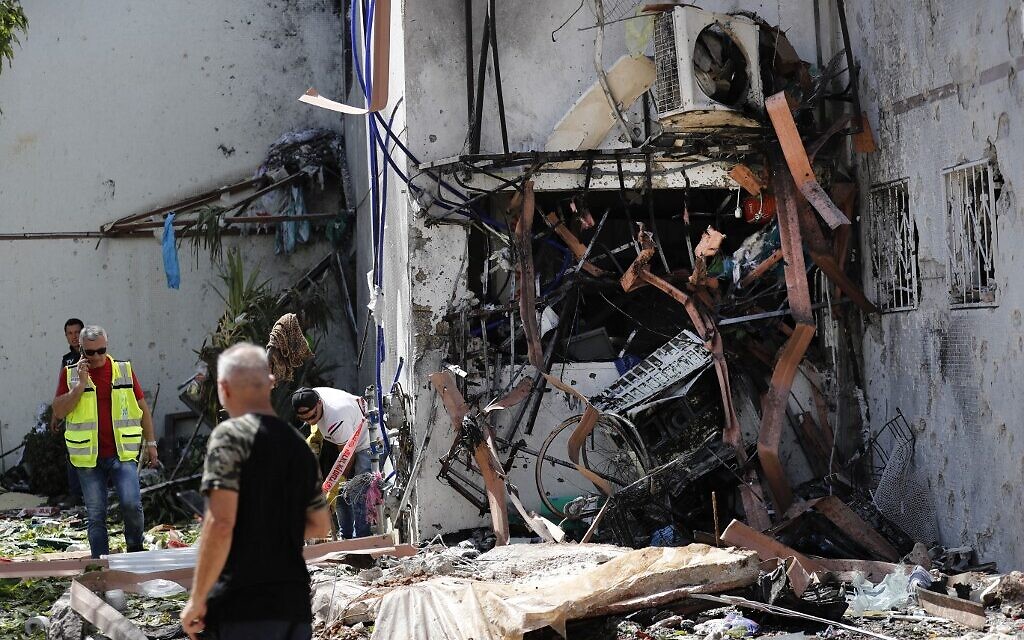A former Israeli general on Sunday said the Israel Defense Forces’ bombing of a tower that housed The Associated Press in the Gaza Strip during May’s conflict amounted to an “own goal,” causing more damage to Israel’s image than it provided operational benefit.
“Bringing down the tower with the AP offices was equivalent to a self-inflicted ‘public relations terror attack’ and an own goal, in our view,” said Maj. Gen. (res.) Nitzan Alon, the former head of IDF Operations.
Alon, who led the military’s investigation into the public relations-related issues connected to the recent conflict, was referring to a May 15 strike on the 12-story Al-Jalaa tower in Gaza City, which sparked immediate criticism from around the world, including from American lawmakers who have long been staunch advocates for Israel.
“Not everyone in the IDF believes this, but I am convinced that this was a mistake. The operational benefit was not worth the damage that it caused diplomatically and in terms of perception,” he said.
Israel claimed the tower was used by Hamas to set up equipment to block GPS signals in order to interfere with the military’s Iron Dome missile defense system, which Israel was using to intercept the rockets, mortar shells, and drones being launched from Gaza.
Though IDF officials have since acknowledged that the military should have better explained its reasons for striking the building, none has publicly said that the bombing was a mistake. In the aftermath of the war — and in part due to lessons learned from the outcry over the strike on the al-Jalaa tower — the military has begun working to better coordinate its public advocacy efforts with its operational actions.
Maj. Gen. Nitzan Alon speaks at the Institute for National Security Studies conference in Tel Aviv on January 28, 2019. (INSS)
“I think that the IDF’s success in terms of public relations was very, very limited. There is a long list of lessons, many that have to do with intra-organizational communication,” Alon said, citing breakdowns in communications within the IDF and between the military and government ministries.
Alon made his comments at a conference hosted by Tel Aviv’s Institute for National Security Studies about the importance of public perception during military conflicts.
Israel fought a punishing 11-day conflict with Hamas, the Palestinian Islamic Jihad, and other terror groups, in the Gaza Strip in May, after Hamas fired six rockets toward Jerusalem in response to clashes that took place in the city at the time. Thirteen people were killed in Israel during the fighting — 12 civilians and one soldier — and some 250 Palestinians were killed in the Gaza Strip, roughly half of them terrorist operatives.
A key feature of the IDF’s tactics during the conflict was the targeting of multi-story towers in the Gaza Strip, each of which it said was used by the Hamas terror group and was thus a legitimate military target.
On May 15, the IDF destroyed the al-Jalaa tower, giving the occupants of the building one hour to evacuate before the airstrike. No one was injured, but the high-rise was flattened into a pile of rubble.

Israeli residents and rescue teams are pictured outside a building hit by a rocket launched from the Gaza Strip, in the southern city of Ashdod, on May 17, 2021. (Ahmad GHARABLI / AFP)
The military initially provided scant information about the reason why the building was targeted, saying only that it housed offices for Hamas’s military intelligence, its research and development department, and a tech unit. Amid international criticism, the IDF elaborated on the justification for its attack, saying the building contained “special” Hamas equipment.
“The target was of high military value to Hamas and was vetted according to rigorous procedures within the IDF, and in accordance with international law,” the IDF said at the time.
Only later did Israel expand further and say that the equipment was meant to interfere with the Iron Dome. Military Intelligence officials also said the seriousness of the electronic warfare issue justified the attack on the building, as well as the decision to bring down the entire structure, rather than just a surgical strike on the floors where Hamas was operating, as that might not have destroyed all of the capabilities in the tower.
Press freedom groups also condemned the attack, which marked a new chapter in the already rocky relationship between the Israeli military and the international media.
Sally Buzbee, the AP’s executive editor, said that the news agency had had offices in the building for 15 years and was never informed or had any indication that Hamas might be operating in the building.
Times of Israel staff contributed to this report.